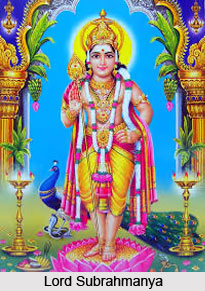 Lord Subrahmanya is the universal deity who is worshipped mostly in South India. He holds a spear in His hand, which is an emblem of power and indicates that He is the ruler of the Universe. Lord Subramanian`s vehicle is the peacock which he rides, thus signifying that He has conquered pride, egoism and vanity. There is a cobra under His feet, which signifies that He is absolutely fearless, immortal and wise.
Lord Subrahmanya is the universal deity who is worshipped mostly in South India. He holds a spear in His hand, which is an emblem of power and indicates that He is the ruler of the Universe. Lord Subramanian`s vehicle is the peacock which he rides, thus signifying that He has conquered pride, egoism and vanity. There is a cobra under His feet, which signifies that He is absolutely fearless, immortal and wise.
Subramanya Shashti
Skanda Sashti is observed on the sixth day of the bright fortnight of the Tamil month of Aippasi (October - November). This day is dedicated to the second son of Lord Shiva- Lord Subramanya, also known as Kartikeya, Kumaresa, Guha, Murugan, Shanmukha and Velayudhan, who on this day, is believed to have annihilated the mythical demon Taraka. Celebrated in all Shaivite and Subramanya temples in South India, Skanda Sashti commemorates the destruction of evil by the Supreme Being.
The worship of Muruga, as Skanda is popularly called in Tamil country and is very old in South India, where Subramanya is worshipped with great devotion. One of the most ancient totem-groups in the South was that of the Nagas (i.e. snakes) and the appearance of a serpent is even today considered by many as betokening the presence of Murugan. Lord Subramanya`s other names are Skanda, Kumaresa, Kartikeya, Shanmukha, Guha, Muruga and Velayudhan.
By about the 6th century, the Skanda cult had shed its association with the earliest indigenous forms of worship practised by the hill-tribes and the Kumara Tantra was looked upon as a branch of the Saiva Tantras, and Skanda was invested with some of the attributes usually associated with Shiva, for instance; Mahayogin, the great Teacher, the great Healer, the Lord of the Bhutas, and as the great Ascetic.
On this day, elaborate festivals are held with grandeur in South India. In many places the festival commences six days before the Sashti day and concludes on the day of the Sashti. During these days, devotees recite inspiring hymns, read stories of Subramanya, and enact the exploits of the Lord on stage. Thousands of people gather for feasts, and massive amounts of camphor are burnt.
Myth of Lord Subramanya
Lord Subramanya is a ray born of the Divine Consciousness of Lord Shiva. Valli and Deivayanai are His two wives who represent the power of action and the power of knowledge. Lord Subramanya is an aspect of the Divine easily accessible in this age of ignorance and lack of faith. He gives material and spiritual prosperity and success to His devotees, if they show even the smallest devotion to Him.
The oldest Tamil hymns refer to Him as the deity of the hilly regions, the God of the tribes of hunters - Velan (He who carries a vel or spear). He was also believed to induce violent passions of love in the minds of girls, and was propitiated by magic rites.
The natives, who are suffering from financial crisis, delay in marriages, and those who are prone to frequent accidents are advised to offer prayers to Lord Subramanya Swamy on this auspicious day by performing abhishekam to Lord Subramanya Swamy. Natives in their natal chart, if Kuja is positioned in the 8th house from moon sign or having Kuja Dosha or under Kuja Dosha or antar dasa, the effect of Kuja will be very severe. So, the natives are advised to perform necessary puja on the auspicious day of Subramnaya Shashti to get rid of their problems. The natives are advised to perform puja with utmost faith to seek the blessing of Lord Subramanyeswara Swamy who could solve all problems. The natives are advised to perform milk abhishekam to Lord Kuja on that day along with the natives name and gotra to get rid of their problems and seek His blessings.









